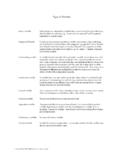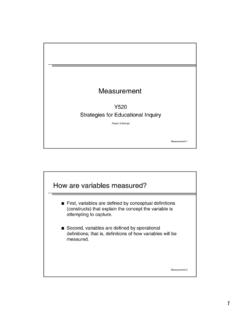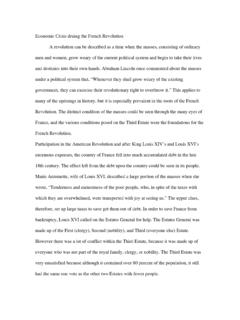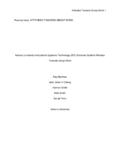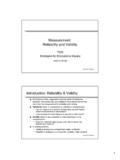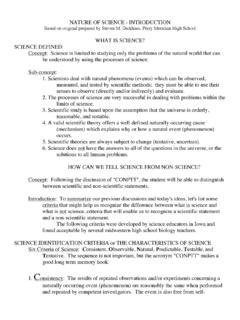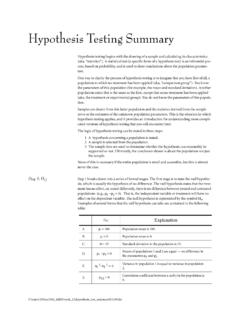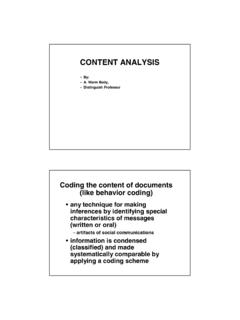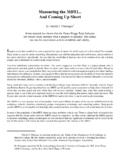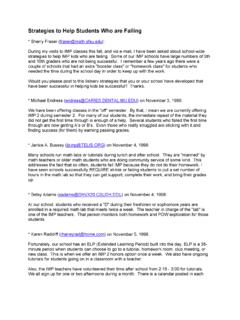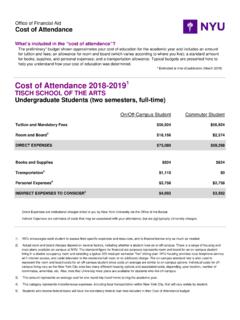Transcription of Effective Learning Techniques: Promising © The …
1 Psychological Science in the Public Interest14(1) 4 58 The Author(s) 2013 Reprints and permission: : Author:John Dunlosky, Psychology, Kent State University, Kent, OH 44242 E-mail: students Learning With Effective Learning Techniques: Promising Directions From Cognitive and Educational PsychologyJohn Dunlosky1, Katherine A. Rawson1, Elizabeth J. Marsh2, Mitchell J. Nathan3, and Daniel T. Willingham41 Department of Psychology, Kent State University; 2 Department of Psychology and Neuroscience, Duke University; 3 Department of Educational Psychology, Department of Curriculum & Instruction, and Department of Psychology, University of Wisconsin Madison; and 4 Department of Psychology, University of VirginiaSummaryMany students are being left behind by an educational system that some people believe is in crisis.
2 Improving educational outcomes will require efforts on many fronts, but a central premise of this monograph is that one part of a solution involves helping students to better regulate their Learning through the use of Effective Learning techniques. Fortunately, cognitive and educational psychologists have been developing and evaluating easy-to-use Learning techniques that could help students achieve their Learning goals. In this monograph, we discuss 10 Learning techniques in detail and offer recommendations about their relative utility.
3 We selected techniques that were expected to be relatively easy to use and hence could be adopted by many students . Also, some techniques ( , highlighting and rereading) were selected because students report relying heavily on them, which makes it especially important to examine how well they work. The techniques include elaborative interrogation, self-explanation, summarization, highlighting (or underlining), the keyword mnemonic, imagery use for text Learning , rereading, practice testing, distributed practice, and interleaved practice.
4 To offer recommendations about the relative utility of these techniques, we evaluated whether their benefits generalize across four categories of variables: Learning conditions, student characteristics, materials, and criterion tasks. Learning conditions include aspects of the Learning environment in which the technique is implemented, such as whether a student studies alone or with a group. Student characteristics include variables such as age, ability, and level of prior knowledge. Materials vary from simple concepts to mathematical problems to complicated science texts.
5 Criterion tasks include different outcome measures that are relevant to student achievement, such as those tapping memory, problem solving, and comprehension. We attempted to provide thorough reviews for each technique, so this monograph is rather lengthy. However, we also wrote the monograph in a modular fashion, so it is easy to use. In particular, each review is divided into the following sections:1. General description of the technique and why it should work2. How general are the effects of this technique? 2a.
6 Learning conditions 2b. Student characteristics 2c. Materials 2d. Criterion tasks3. Effects in representative educational contexts4. Issues for implementation5. Overall assessmentImproving Student Achievement 5 IntroductionIf simple techniques were available that teachers and students could use to improve student Learning and achievement, would you be surprised if teachers were not being told about these techniques and if many students were not using them? What if students were instead adopting ineffective Learning techniques that undermined their achievement, or at least did not improve it?
7 Shouldn t they stop using these techniques and begin using ones that are Effective ? Psychologists have been developing and evaluating the efficacy of techniques for study and instruc-tion for more than 100 years. Nevertheless, some Effective techniques are underutilized many teachers do not learn about them, and hence many students do not use them, despite evidence suggesting that the techniques could benefit student achievement with little added effort. Also, some Learning tech-niques that are popular and often used by students are rela-tively ineffective.
8 One potential reason for the disconnect between research on the efficacy of Learning techniques and their use in educational practice is that because so many tech-niques are available, it would be challenging for educators to sift through the relevant research to decide which ones show promise of efficacy and could feasibly be implemented by stu-dents (Pressley, Goodchild, Fleet, Zajchowski, & Evans, 1989).Toward meeting this challenge, we explored the efficacy of 10 Learning techniques (listed in Table 1) that students could use to improve their success across a wide variety of content The Learning techniques we consider here were cho-sen on the basis of the following criteria.
9 We chose some techniques ( , self-testing, distributed practice) because an initial survey of the literature indicated that they could improve student success across a wide range of conditions. Other tech-niques ( , rereading and highlighting) were included because students report using them frequently. Moreover, stu-dents are responsible for regulating an increasing amount of their Learning as they progress from elementary grades through middle school and high school to college. Lifelong learners also need to continue regulating their own Learning , whether it takes place in the context of postgraduate education, the workplace, the development of new hobbies, or recreational , we limited our choices to techniques that could be implemented by students without assistance ( , without requiring advanced technologies or extensive materials that would have to be prepared by a teacher).
10 Some training may be required for students to learn how to use a technique with fidelity, but in principle, students should be able to use the techniques without supervision. We also chose techniques for which a sufficient amount of empirical evidence was available to support at least a preliminary assessment of potential effi-cacy. Of course, we could not review all the techniques that meet these criteria, given the in-depth nature of our reviews, and these criteria excluded some techniques that show much promise, such as techniques that are driven by advanced teachers are most likely to learn about these tech-niques in educational psychology classes, we examined how some educational-psychology textbooks covered them (Ormrod, 2008; Santrock, 2008; Slavin, 2009.)
